The scans of QR barcodes have officially taken off.
ScanLife has released a mobile trend report that has indicated that there has been a tremendous spike in the number of people who are scanning quick response codes.
The report showed that in the month of June alone, there were 5.3 million scans.
This is the highest number of scans that has ever been achieved in a single month. In that quarter, the number of scans per minute jumped to 120. In comparison, the second quarter in 2011 had 24 scans per minute. The report also pointed out that there were 4 million new people who took part in scanning in this year’s second quarter.
In 2011, the largest quick response codes campaign in Q2 brought in just over 30,000 scans.
This year, though, the biggest quick response codes campaign resulted in more than 2 million scans. The efforts that brought in the largest number of scans were those that had to do with loyalty programs or contests as their main purpose for scanning. Other types of popular campaigns included app downloads, social media content, or video content.
The report from ScanLife is based on data regarding the use of quick response codes and other mobile barcodes, both through its own platforms as well as QR code traffic from third parties.
As the amount of use of these barcodes continues to increase by smartphone users, it is vital that marketers pay close attention to the demographics of the individuals who are scanning the quick response codes.
On the whole, the most common QR code scanners are male. In fact, they make up 69 percent of the total scans. Similarly, it is Android device users who are scanning the most, as they are responsible for 53 percent of the total. Apple iOS devices, on the other hand, scan the barcodes 43 percent of the time.
Age is another important factor, as more than 75 percent of the people who scan quick response codes are aged 25 years or higher. Location also makes a difference, as 60 percent of people will scan a QR barcode from home.

